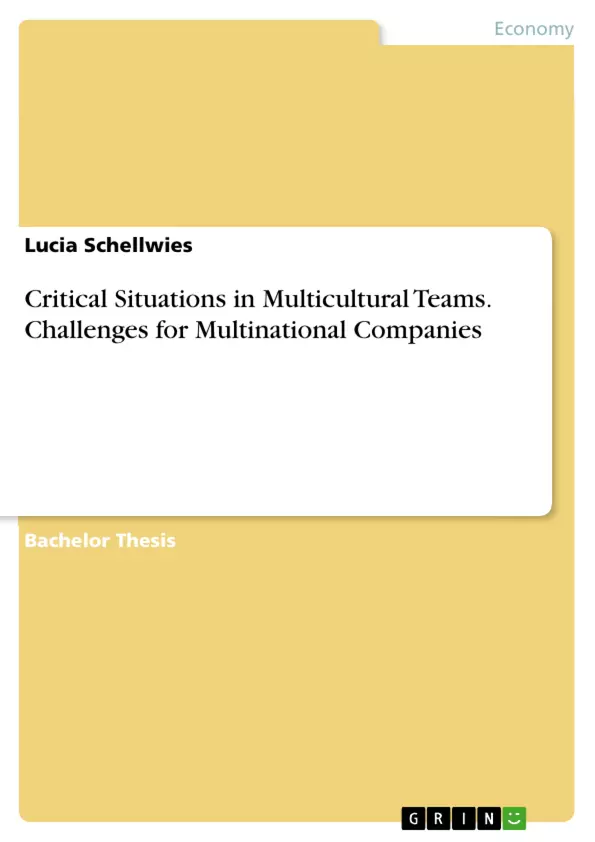As a result of the increasing globalization the business world gets interconnected and more and more organizations are operating internationally. Such multinational companies often rely on successful teamwork to reach goals and to compete on the fast-paced global market. Indeed, teamwork plays a variety of important roles; when employees with varying skill sets and ideas are working together in a team not only information and knowledge can be shared, successful teamwork can also lead to faster results. A group of employees clearly can achieve more than one individual alone.
Teams, whose members come from different nations and backgrounds place special demands on operations, diversity clearly adds complexity and a longer learning curve for establishing effective processes.
In the multicultural team, obviously, culture itself is one significant characteristic, in addition the role of emotions in the team have gained increasing interest in the last years. Nevertheless, research in this field is scarce and through adding an additional variable – culture, the multicultural character is making research even more complicate. Practitioners report that where people work together, emotions are not far to seek. While influencing our thinking and behavior, the effects of emotions and the resulting behavior can either be positive, or negative.
In multicultural teams an awareness of emotions seems to be especially important as cultural differences in emotion processing and diversity among members may cause negative emotion and lead to conflict and misunderstandings what may have serious consequences reducing performance.
The aim of this paper is to identify challenges for multinational teams focusing on emotions within the team, and to propose emotional intelligence as an approach to multicultural team effectiveness.
The two research questions guiding this work are:
1. What role do emotions play in the multicultural team?
2. Is emotional intelligence connected with multicultural team effectiveness?
Inhaltsverzeichnis (Table of Contents)
- Introduction
- Theoretical Background
- An Era of Globalization
- The Character of a Multicultural Team (MCT)
- Definition of a Team
- Types of Diversity in Teams
- The Concept of Culture
- What exactly is Culture?
- Dimensions of Culture
- The Multi-Level Model of Culture
- Emotions: An Attempt for classification
- Emotions in the Workplace
- The Group Emotion
- Emotion Management in Multicultural Teams
- Emotional Meaning Across Cultures
- Basic Emotions and Expressions
- The Basic Emotions Approach
- The Basic Expressions Approach
- Emotion Display and Culture
- Emotions and Diversity
- Trust in Multicultural Teams
- The Theory of Emotional Intelligence
- The Terms Emotion and Intelligence
- Intelligence Defined
- Emotions Defined
- Models of Emotional Intelligence
- The Ability Model
- Measurement of Emotional Intelligence
- Perceiving emotions
- Performance of Multicultural Teams
- The Health of a Team
- The Five Frames of Performance and Health
- Multicultural Team Effectiveness
- A Model for Multicultural Team Effectiveness
- Stages of Emotion Process
- Feedback Theory
- Appraisal Theory
- An Emotion Process Model
- Stages of the Emotion Process Model
- Emotional Intelligence as A Success Factor for Multicultural Teams
- Mutual Trust
- Team identity
- Team Efficacy
- Conclusion
Zielsetzung und Themenschwerpunkte (Objectives and Key Themes)
This paper aims to identify challenges for multinational teams, focusing on emotions within the team. It also proposes emotional intelligence as an approach to multicultural team effectiveness. The research questions guiding the work are:- What role do emotions play in the multicultural team?
- Is emotional intelligence connected with multicultural team effectiveness?
- The impact of globalization on business operations and teamwork.
- The importance of understanding cultural differences in emotion processing and expression.
- The role of emotional intelligence in fostering multicultural team effectiveness.
- The challenges of managing emotions in multicultural teams.
- The relationship between emotions and team performance.
Zusammenfassung der Kapitel (Chapter Summaries)
The paper begins by introducing the increasing global interconnectedness of the business world and the importance of teamwork in multinational companies. It then delves into the theoretical background, defining multicultural teams and exploring different dimensions of culture, with a particular focus on how culture influences emotional expression and processing. The paper examines the role of emotions in the workplace and investigates the concept of emotional intelligence, its various models, and how it can be measured. The paper further explores the performance of multicultural teams, examining factors contributing to team health and effectiveness, and presents a model for understanding multicultural team effectiveness. It then delves into the stages of emotion processing, analyzing different theories like feedback theory and appraisal theory, and outlining a comprehensive emotion process model. Finally, the paper explores how emotional intelligence can act as a success factor for multicultural teams, highlighting the importance of mutual trust, team identity, and team efficacy.Schlüsselwörter (Keywords)
The main focus of the paper is on multicultural teams and emotional intelligence. Other key concepts include globalization, cultural differences, emotional expression, emotion processing, team performance, team effectiveness, mutual trust, team identity, and team efficacy.- Quote paper
- Lucia Schellwies (Author), 2014, Critical Situations in Multicultural Teams. Challenges for Multinational Companies, Munich, GRIN Verlag, https://www.grin.com/document/283325



